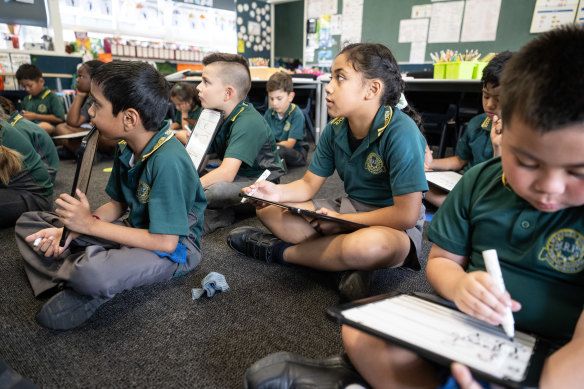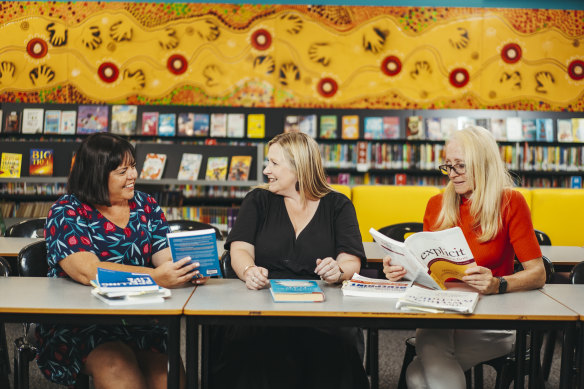By Lucy Carroll
It’s the first lesson of the school day. Year 1 students sit on the classroom floor to spend half an hour reading and writing using phonics before tackling a string of vocabulary tasks.
“We are checking their knowledge constantly, so we pick up problems in real time,” says Troy Verey, the deputy principal at Marsden Road Public in south-west Sydney. “The kids use mini whiteboards to record answers and show they grasp concepts, which keeps them engaged and on-task.”

Students at Marsden Road Public in Liverpool in a literacy lesson.Credit: Wolter Peeters
The school, where more than 40 per cent of students are from the lowest socio-educational quartile, is a stand-out for its above-average NAPLAN results – especially in writing – when compared with pupils from a similar background.
“We also have reading tests three times a year to help catch the children who are falling behind,” he says.
In a new report released on Sunday, The Reading Guarantee, the Grattan Institute has called on governments to set ambitious new targets to lift the level of proficient readers from 68 to 83 per cent in the next decade, and 90 per cent in the long term.
One in three Australian children failed to meet new benchmarks for literacy in last year’s NAPLAN tests. In NSW, that equated to 109,000 students tested who were unable to read at the level expected for their grade.
Grattan’s education program director Jordana Hunter said decades of disagreement about how to teach reading and lack of guidance to schools were key causes of the problem, but noted NSW is now a leading state for using phonics to teach reading and evidence-based instruction.
“NSW has committed to an evidence-based approach to reading, but now should dial up efforts to guarantee best practice is deeply embedded in all schools,” Hunter said.
“We need a reading revolution to make sure students aren’t left behind, and a huge effort to get it right in every classroom across the country.”
At Marsden Road, teachers have used phonics – where students decode words by sounding out letters – for the past eight years, while NSW mandated the use of phonics in kindergarten to year 2 in 2023.
The Grattan report has already been met with support from federal Education Minister Jason Clare, who said the current National School Reform Agreement didn’t include the targets or reforms to “move the needle”.
“The new agreement we strike this year needs to properly fund schools and tie that funding to the sort of things that work,” Clare said.
For students who are the hardest hit by poor reading performance, the Grattan estimated the cost to Australia is about $40 billion over their lifetimes. “England and Ireland, and about 30 US states, have made big policy changes to help schools to teach according to the evidence – with great results,” the report said.
The report says schools across the country need access to high-quality curriculum resources, and schools should have reading instruction specialists who would be paid $40,000 more than the top-paid teachers. It also urged the rollout of “demonstration” schools to showcase best-practice teaching.
The Grattan said much of the workload fell to already-stretched principals, who were expected not only to do their own research but to lead change management in their schools. But, it said once clear policies had been set principals should be held accountable if reading progress was poor.
Verey said that Marsden Road Public sets regular attainment and growth targets for its students, and conducts reading tests three times a year to capture any children falling behind.
“Teachers also do three to five read-aloud sessions a day, where students follow along a text and are asked vocab and comprehension questions along the way,” he said.
At another western Sydney school, Riverwood Public, assistant principal Julie Mavlian said teachers do reading assessments three times a year to make sure students can blend letter sounds to read words.
“We also collect data throughout the year, and any student not meeting benchmarks are offered intervention. The earlier you intervene, the better. We also do fluency practice where students practise reading with a partner, and they can see their success,” Mavlian said.

Riverwood Public’s deputy principal Sophie Roberts, acting principal Emma Meddows and assistant principal Julie Mavlian. Credit: Dion Georgopoulos
“We have many transient students but last year, of those students who had been with us throughout school, 92 per cent were reaching proficiency. We want to lift results for every student – reading is the key to a lifetime of success.
A NSW Department of Education spokesperson said the government supported a commitment to improve the number of children who can read proficiently.
“NSW public schools are substantially delivering on the steps identified in the report and, in many cases, leading the way. We take an evidence-based approach to the teaching of reading, backed by research on the science of reading.”
NSW conducts universal screening through the best start kindergarten assessment and has a year 1 phonics check.
With Robyn Grace